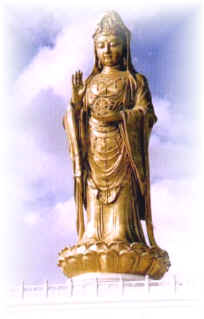Putuo Mountain, on one of the Zhoushan Islands about 100 sea miles off the eastern coast of Hangzhou Bay in Zhejiang Province, is one of the four Buddhist shrines in the country, covering an area of 12.5 square kilometers. Its main peak, the Peak of Buddhist Top, is 300 meters above sea level.
Putuo Mountain is noted for its rough terrain and exquisite landscape. The clouds like sails, scattered about, and the sea and the sky bore a same blurred color. The mountain rises alone over the East China Sea. Sailing near, one can see verdant trees, strange rocks, mysterious temples, and huge inscriptions carved on stones. The mountain also has a stretching beach and a lot of caves, surrounded by floating clouds.
 |
|
Putuo Mountain is famous both at home and abroad, especially among Southeast Asian countries. Its first temple is called Guanyin Temple, built in 863 AD. The island cape is encircled by numerous protruding reps and deep hidden grottoes. Putuo Mountain is not only a sacred place of Buddhism -- "Buddhist Land of South Sea", but also an ideal summer resort. It has a mild climate, intriguing surroundings and unique scenery. The three famous temples are Puji Temple, Fayu Temple and Huiji Temple, which are the three largest ones among the 20-odd existing well-preserved temples nationwide.
 Cultural Heritage
Cultural Heritage
1. Temples
The principal temple -- Puji Temple -- with more than 200 halls built in the Song Dynasty (960-1279), is the chief temple where Guanyin (a Bodhisattva) is enshrined, with an area of 11,000 square meters.
The Fayu Temple, consisting of halls in six layers, is the second largest temple on the mountain and was constructed in the Ming Dynasty (1368-1644).
The Huiji Temple, built in the Ming Dynasty, is located on the top of Putuo Mountain. In front of the temple are some 1,000 stone steps. The temple, the third largest on the mountain, has four halls, seven palaces and six attics.
2. Caves and Stones
Putuo Mountain is also the site of some famed stone caves, such as the Chaoyin, Chaoyang and Fanyin caves. Among them, the Chaoyin and Fanyin caves are the most renowned. When the sea surges, water tumbles into the Chaoyin Cave and bumps into the rocks inside with a thunderous roar, and looks like a madly gyrating dragon from a bird's-eye view.
The Fanyin Cave (Cave of Buddhist Sound) is sandwiched between two steep cliffs of some 100 meters in height. The cave winds its way towards the sea. When the sea swells, the waters pour into the cave with thunderous roars. A stone stair leads from the mountain top to a rock platform built into the cave wall, half way above the bottom with a marvelous view of the sea.
There are also many oddly-shaped stones, the 20-odd most famous ones of which include Pantuo Stone, the stone of Two Tortoises listening to preaching, and the stone of Sea and Sky Buddhist Kingdom, etc.
3. The Beaches
The island is surrounded by quite a few beaches. The Baibusha Beach, along the east coast and 1.5 km. in length, is the best bathing beach. It is flat and covered with soft golden sand.
